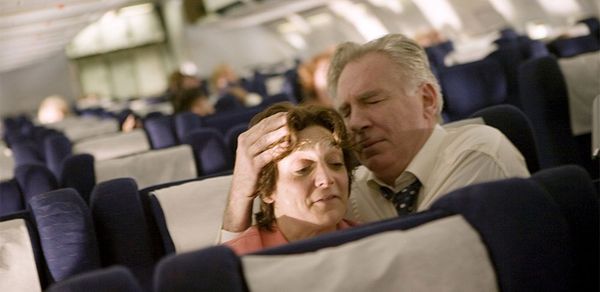Eye For Film >> Movies >> United 93 (2006) Film Review
United 93
Reviewed by: Anton Bitel

Amongst the 44 passengers and crew on board United Airlines' San Francisco-bound flight 93 on the morning of September 11th, 2001, were four young Islamic zealots with a desperate plan. Shortly after the flight had commenced, they hijacked the plane, intending to crash it into a Washington target (probably the White House), at the same time as co-conspirators were flying other fuel-laden airliners into the Twin Towers and the Pentagon to destructive effect. As the passengers of Flight 93 realised the nature of their awful predicament, they decided to storm the cockpit and, in the struggle that ensued, the plane came down in a Pennsylvanian field, killing everyone on board.
In a sequence that is almost as irresistible as gravity itself, disasters must eventually be followed by disaster movies, typically made-for-TV confections of schlocky melodrama, sensationalist exploitation and crude catharsis. Yet occasionally such films display an enquiring sensitivity to their subject matter that transcends the genre, like Gus Van Sant's Elephant (2003), with its dispassionately blank riff on the Columbine High School killing spree, and like Paul Greengrass' United 93, a real-time reconstruction of events on the doomed flight that manages to encapsulate all the anxieties and sorrows of our age.

In the Seventies, the Airport franchise used predictable character arcs, redemptive storylines and last-minute deliverances to turn its airborne nightmare scenarios into palatable entertainment, but in United 93, where from the start the only way is down, there is no comfort or hope on offer. Here, all the "characters" are both respectful representations of people who were all too real, and also anonymous ciphers, no better known to us than any fellow passengers on a plane, and with personal lives only hinted at by the frantic calls home in the flight's final minutes. With no attempt to make them superhuman, or even cinematic, these are ordinary people like you and me, whose heroism is for that very reason all the more affecting and involving.
The one trope that United 93 has lifted wholesale from the disaster genre is the type of scene in which authorities in a control room struggle to cope with the enormity of what is happening. In fact, the film switches back and forth from a control tower in Newark to the Control Centers in Boston and New York, and from the Federal Aviation Administration's command center in Virginia to a military operation centre in upstate New York. The effect is to give a broader perspective on that fateful morning, while also showing that the dire need for decisive action in the air was mirrored precisely on the ground. Here however, unlike in other movies, the control room scenes fall somewhere between "sim" and "real-world" (to appropriate expressions used in the film itself), based upon extensive interviews with all the personnel involved, as well as all available documentation of the incidents, and even featuring many of the actual ground staff reenacting their own roles in the unfolding chaos.
Even more claustrophobic are the scenes on the plane itself. While no one will ever know exactly what transpired there, Greengrass has drawn on years of experience making docudramas (Bloody Sunday, Omagh, Resurrrected, The Murder of Stephen Lawrence) to create a compelling (if inevitably speculative) version of events. Giving each cast member profiles of the people they were portraying (based on relatives' testimonies and recordings of on-board phone calls), he then allowed them to improvise in long real-time takes for the sort of raw verite that eludes more prescribed screenplays. The result is a harrowing, and utterly believable, scenario that places us right in the aisle seat of the so-called War on Terror, and, unlike the over-the-top shenanigans of this year's Poseidon, or Snakes On A Plane, the real-life situation of United 93 confronts us directly and uncompromisingly with the question of what we ourselves would have done under such rapidly evolving and horrific circumstances.
It is a bumpy ride in other ways, too, as uneasy parallels are drawn between the passengers and the hijackers. Both groups are shown leaving grim farewell messages with their loved ones, both are depicted violently storming the cockpit, and both seem equally terrified; and yet far from suggesting any sort of moral equivalence between perpetrator and victim, Greengrass is doing something far more subtle.
The events of 9/11 did, of course, actually take place, no matter how similarly (or differently) to how they are depicted in this film; but no less real was their undeniable symbolic value, and it is this, on top of all the meticulously researched facts, that Greengrass has managed to bring to us with devastating impact. For within the cramped confines of Flight 93 he depicts the explosive emergence of a new kind of world and a new kind of war, where friend is indistinguishable from foe, where civilians are pushed right to the front line, and where, in the absence of an experienced pilot, everyone is left vainly fighting to wrest back the controls from a threat that is barely comprehended.
Reviewed on: 02 Jun 2006




















